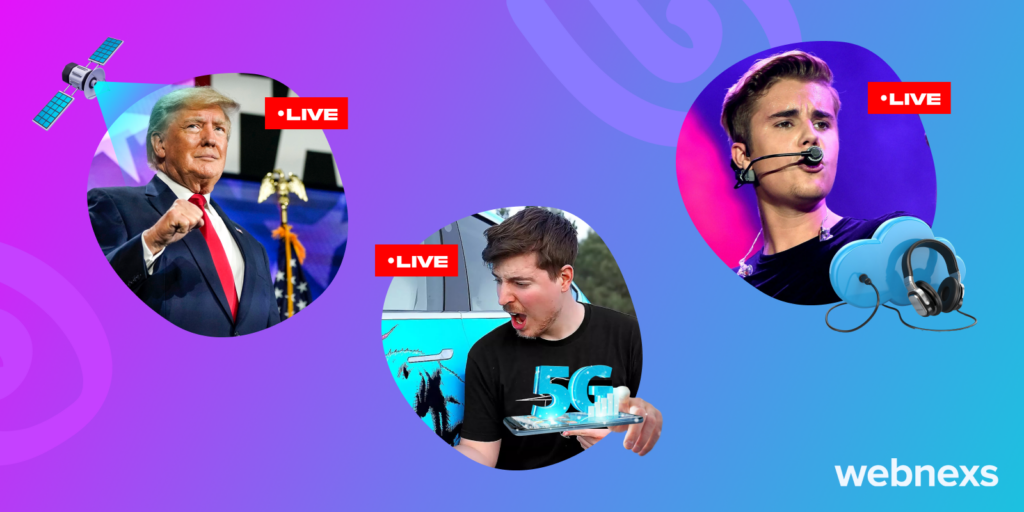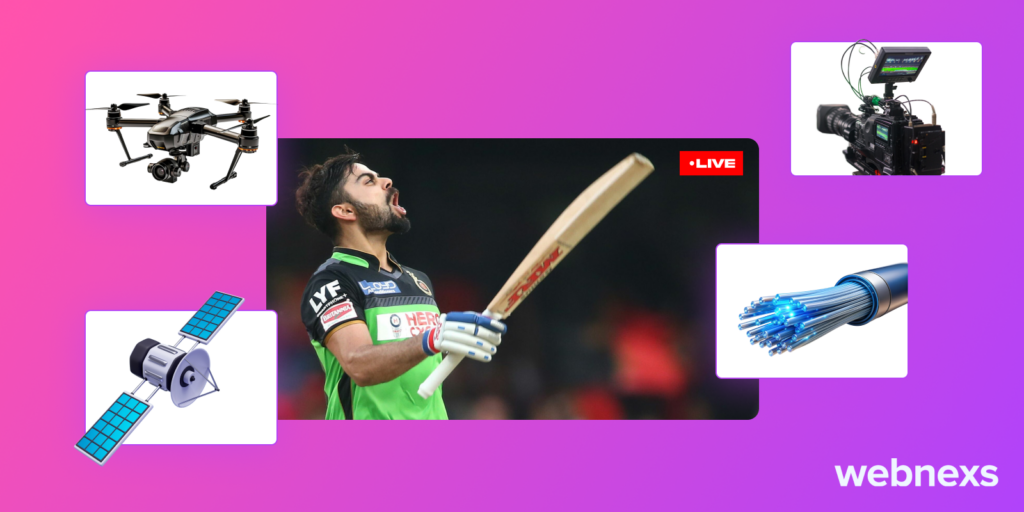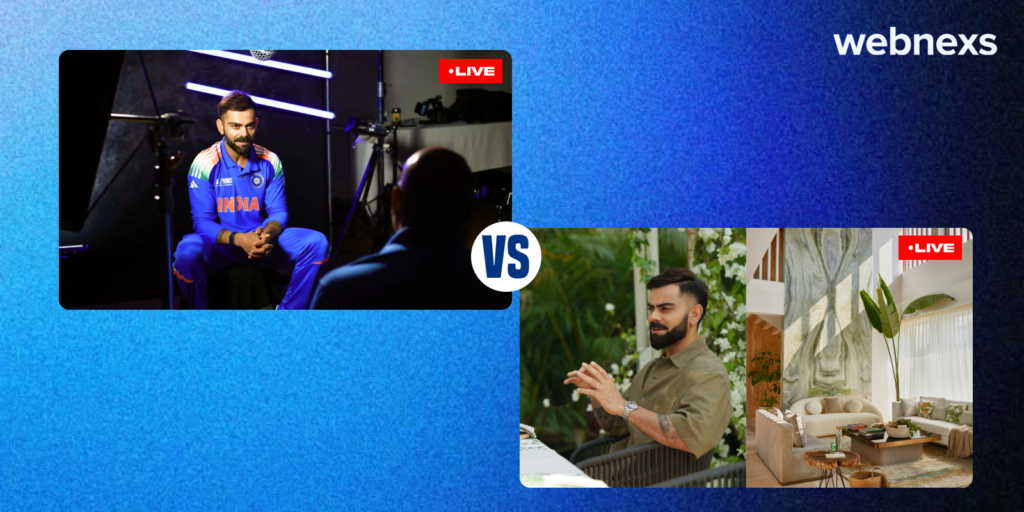Live events like the FIFA World Cup attract millions of viewers worldwide, but few consider the technology behind seamless live coverage.
“According to recent studies, the global live streaming market is expected to reach $247 billion by 2027, driven by the growing demand for real-time content”
Outdoor broadcasting (OB) is the backbone of capturing and streaming live events, blending advanced technology with creative execution while tackling logistical challenges.
Webnexs specializes in delivering high-quality live broadcasts, ensuring smooth coverage of major events like sports championships, concerts, and global audience. With our expertise, we’ll guide you through the world of outdoor broadcasting and how it transforms live event experiences.
What is Outdoor Broadcasting?
Outdoor broadcasting refers to the process of capturing, producing, and transmitting live events outside of a conventional studio setup. Whether it’s a sports event, political rally, or music festival, outdoor broadcasting ensures real-time delivery of high-quality content to audiences globally.
“Live sports streaming alone accounts for 37% of all internet traffic, showcasing the immense popularity of real-time content consumption”.
To facilitate OB van live streaming, a dedicated outdoor broadcasting van is used, equipped with essential tools like professional cameras, microphones, and remote production equipment. This setup allows for on-the-go capturing and transmission, ensuring a seamless live streaming experience.
Key Methods Of Outdoor Broadcasting

Satellite Broadcasting
Satellite broadcasting is widely used for global sports events, political rallies, and news reporting. It allows real-time video transmission from virtually any location, making it a preferred choice for international coverage.
- Advantages: High-speed data transmission, extensive coverage, reliable in remote locations.
- Challenges: Expensive infrastructure, requires professional setup and maintenance.
“Satellite broadcasting reaches over 200 million homes worldwide, providing unparalleled global coverage”.
Mobile Streaming Solutions
Advancements in 4G/5G technology have made mobile streaming a viable option for live event coverage. Journalists, influencers, and content creators often use smartphones and portable encoders to broadcast live from anywhere.
- Advantages: Cost-effective, easy to set up, suitable for small-scale events.
- Challenges: Dependent on network strength, lower video quality than traditional OB setups.
“Over 60% of video content is consumed via mobile devices, making mobile streaming an essential part of modern broadcasting”
Cloud-Based Live Production
Cloud-based solutions reduce the reliance on physical production units by enabling remote control of live broadcasts. This method is growing in popularity among corporate events, eSports, and online concerts.
- Advantages: Scalable, requires minimal on-site equipment, cost-efficient.
- Challenges: Requires a stable internet connection, limited by cloud service capabilities.
“The global cloud video streaming market is expected to surpass $60 billion by 2028, driven by the rise in remote production”.
Use Cases of Outdoor Broadcasting
Sports Events
Live sports streaming demands a quick and mobile setup for capturing on-field action and delivering seamless real-time coverage to fans. An OB van deployed for this purpose ensures that no crucial moment is missed, providing high-definition live feeds.
“Studies show that 58% of sports fans prefer to watch live events online rather than on traditional TV”.
Concerts and Live Shows
Music festivals and live performances require high-quality audio-visual setups to broadcast seamlessly to global audiences. Outdoor broadcasting extends the reach of these events, enabling fans worldwide to enjoy the experience in real-time.
“The live concert streaming market is projected to grow at a CAGR of 12.2% in the next five years.
Political Rallies and Public Speeches
Political events, including rallies, debates, and public speeches, require robust outdoor broadcasting setups to cover large gatherings efficiently. OB vans provide high-quality, secure, and real-time coverage, ensuring the message reaches a broader audience.
News and Disaster Reporting
Breaking news and disaster coverage demand immediate broadcasting from ground zero. OB with the help of OB vans provide mobile studios equipped with real-time transmission capabilities, ensuring timely and accurate reporting even in challenging environments. Over 65% of news consumers prefer live video updates over written articles.
Corporate Events
Companies use outdoor broadcasting for product launches, shareholder meetings, and press conferences. Live streaming these events enhances brand visibility, keeps stakeholders informed, and broadens audience engagement.
Educational and Awareness Campaigns
Outdoor broadcasting is instrumental in delivering educational content and public awareness campaigns. By live-streaming informative events, broadcasters can reach a larger audience, spreading awareness on critical issues such as health, safety, and social welfare.Online education platforms using live streaming have seen a growth rate of 21% year over year.
How Does Outdoor Broadcasting Work?

Outside broadcasting involves multiple moving parts, from camera operators capturing footage to technical directors managing live feeds. The process can be broken down into several key steps:
1. Setup & Camera Deployment
The OB team first assesses the location to determine the best positions for cameras, microphones, and other equipment. Depending on the event, a combination of stationary, handheld, and drone cameras may be used to capture different angles and perspectives.
2. Signal Transmission & Routing
Once footage is captured, it is transmitted from cameras to an Outside Broadcast (OB) truck or a mobile control room using wired or wireless connections. This can include:
- Fiber optic cables for high-quality video transmission.
- Wireless RF (Radio Frequency) links for remote cameras.
- Satellite uplinks or bonded cellular technology for live streaming.
3. Live Production & Switching
Inside the OB truck, the production team manages multiple video and audio feeds. Key components in this process include:
Video Switchers – Enable seamless switching between camera angles.
Audio Mixing Consoles – Balance sound levels and remove background noise.
Multiviewers – Allow producers to monitor multiple feeds simultaneously.
Graphics & Overlay Systems – Add scoreboards, captions, or visual effects in real-time.
4. Broadcasting & Streaming
Once the production is ready, the final live feed is transmitted to audiences through:
Television Broadcast Networks – Traditional satellite or cable TV channels.
OTT & Streaming Platforms – YouTube Live, Facebook Live, and dedicated apps.
Radio & Audio Streaming – For audio-only broadcasts like live commentary.
5. Post-Production & Content Repurposing
After the live event, recorded footage is edited for highlights, replays, and social media clips. This helps broadcasters maximize content engagement and reach a wider audience.
The Technology Behind Outdoor Broadcasting
Outdoor broadcasting (OB) relies on multiple transmission methods to deliver seamless live coverage from the field to audiences worldwide. These technologies ensure high-quality video and audio are transmitted efficiently:
- Satellite Transmission – A trusted and widely used method, satellites provide stable, long-distance signal transmission, making them ideal for live sports, news, and large-scale events.
- Fiber Optic Networks – Offering high bandwidth and ultra-low latency, fiber optics are preferred for high-definition (HD) and 4K broadcasts, ensuring crystal-clear visuals with minimal lag.
- Wireless Connectivity – The rise of 5G networks enhances OB by enabling mobile broadcasting, reducing reliance on physical infrastructure while improving flexibility in remote locations.
Signal Routing and Mixing
Much like a city’s traffic system, signal routing in OB ensures multiple video and audio feeds are managed efficiently. Cameras, microphones, and other input sources transmit data to a central hub—usually an OB van—where signals are processed and directed to production teams.
Mixing plays a crucial role in enhancing the viewing experience. Using a production switcher, operators blend various camera angles, audio inputs, and live graphics to produce a polished and engaging final output. This real-time process ensures that only the best footage reaches viewers.
Once mixed, the content is encoded and distributed through satellite links, fiber optic lines, or wireless networks, ensuring smooth transmission to television channels, streaming platforms, and digital devices.
In-Studio vs. Outdoor Broadcasting

Both in-studio and outdoor broadcasting have distinct advantages. While outdoor broadcasting provides dynamic, real-time coverage from the event location, it also requires complex logistics, higher costs, and adaptability to unpredictable environmental conditions.
On the other hand, studio-based production offers a controlled setting with consistent quality, but it lacks the immersive experience and spontaneity of live on-location reporting.
The Rise of Hybrid Broadcasting with REMI
The Remote Integration Model (REMI) bridges the gap between these two approaches. With REMI, camera feeds and audio signals from an event location are transmitted to a centralized studio for production, reducing on-site equipment needs. This method is cost-effective and efficient but demands high-speed internet and minimal latency for optimal performance.
Striking the Right Balance
To maximize efficiency, many broadcasters adopt a hybrid approach, integrating OB, studio production, and REMI solutions. However, this method requires careful coordination, strong network infrastructure, and continuous staff training to ensure seamless execution across multiple production environments.
Benefits of Using an Outdoor Broadcasting
- Mobility and Flexibility: Enables coverage of events from any location without requiring a permanent studio setup.
- Live Production Capability: Built-in production tools allow on-site mixing, editing, and broadcasting.
- Cost-Effectiveness: More affordable than setting up a temporary studio for short-term events.
- High-Quality Transmission: Equipped with advanced technology to deliver HD or 4K video streams via satellite, fiber optics, or 4G/5G networks.
- Multi-Camera Functionality: Supports multiple camera angles, enhancing audience engagement.
- Quick Setup and Deployment: Ideal for fast-paced news coverage and spontaneous live broadcasts.
How Webnexs Helps You Seamlessly Broadcast Live Events from an Outdoor Broadcasting
With the growing demand for live streaming, Webnexs provides an advanced live streaming platform that integrates seamlessly with OB setups. Whether broadcasting sports, concerts, or corporate events, Webnexs offers:
- Ultra-Low Latency Streaming: Ensures real-time audience engagement without delays.
- Mobile Optimization: Allows broadcasters to manage live streams on the go.
- Advanced Analytics: Provides insights into stream quality, viewership, and engagement metrics.
- Cloud-Based Streaming: Eliminates the need for additional hardware, making broadcasting effortless.
“Businesses using live streaming experience a 35% higher audience engagement rate compared to recorded videos”.
Start your business with Webnexs today and experience seamless outdoor broadcasting like never before!

